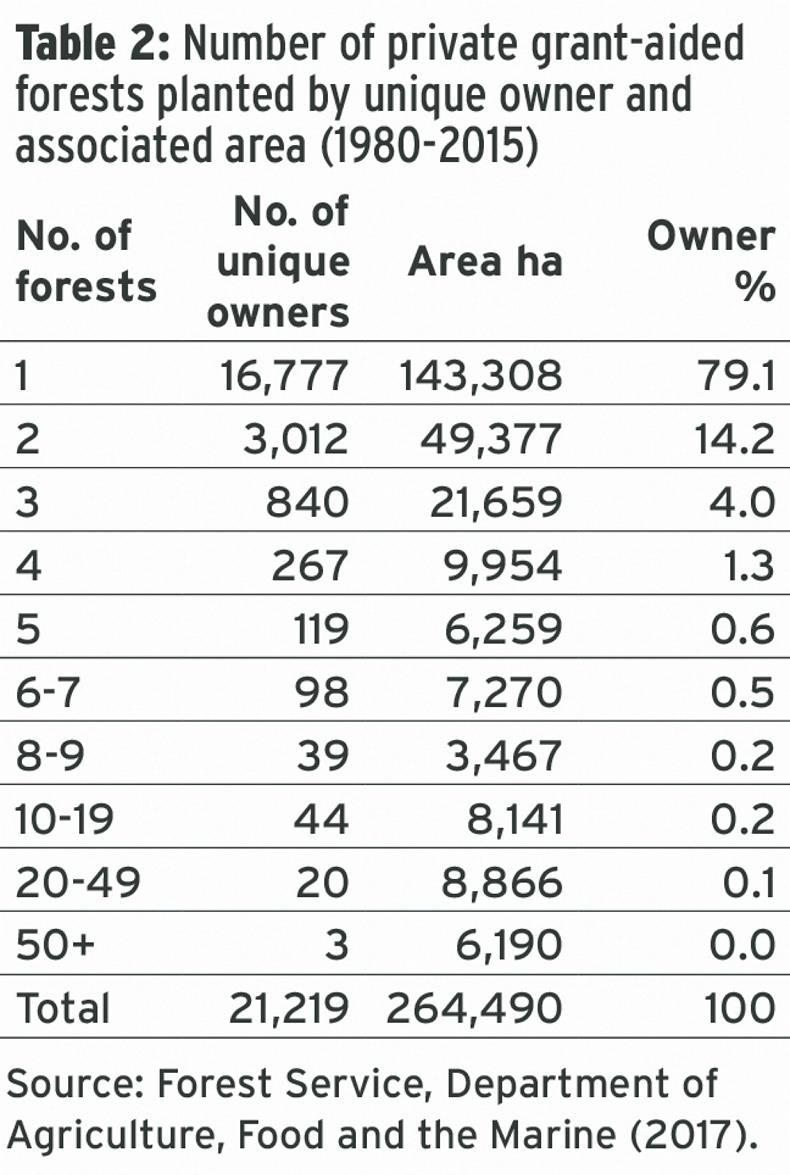Surveys and polls that assess forest owners’ views on forestry usually try to determine levels of satisfaction – or dissatisfaction – based on comparisons between forestry and other land uses. Surveys are unlikely to provide tangible information unless owners are asked: “Have you repeat planted or would you plant again, if suitable land is available?”
The ability to attract repeat customers is the real measure of a product or service and, in this regard, forestry is no different from any other business.
We now know from data supplied by the Forest Service, Department of Agriculture, Food and the Marine that one-third of all forest owners who planted under the Afforestation Grant and Premium Scheme during the past 10 years planted again.
These have established more than one forest (Table 1) as 2,542 out of 7,494 forest holdings were repeat plantings according to the Department report Ireland’s Forests – Annual Statistics 2016.
While 34% of landowners established forests for at least the second time, 40% of Afforestation Scheme approvals in counties Tipperary and Kilkenny were repeat plantings, with an average of 38% achieved in counties Carlow, Clare, Kerry and Offaly (Table 1).
Farm forestry
The average size of plantations established during this period was 7.8ha, with farmers planting over 90% of the afforestation programme. This would indicate that large-scale investors have made little inroads into the afforestation programme and farmers are still the main forest owners.
This is in contrast with the overall planting data for the 36-year period 1980-2015 inclusive, when 20% of landowners repeat-planted (Table 2). However, although second and subsequent planting only averaged one-fifth of holdings during this period, 46% of the total area was repeat-planted by landowners who, in some instances, established multiple forests. For example, 20% (4,442) of forest owners planted 46% (121,183ha) of the total area.
It is significant that farmers planted “83% of private lands afforested between 1980 and 2015” according to the report, with high non-farmer participation in the early years.
“Farmers and non-farmers were planting, on average, equal amounts of forests throughout the 1980s and up to the early 1990s,” the report states.
“A feature of the period was the higher average forest parcel size planted by non-farmer investors (15ha), compared to an average of 5ha for farmers. From 1993 up to 2014, farmer planting has dominated the afforestation programme with over 90% of all planting carried out by farmers.”
Satisfaction
That one-third of the annual afforestation programme represents repeat planting, indicates a significant level of satisfaction among owners with their decision to plant.
Although the Forest Service does not have data on the location of the second and subsequent plantations, such as distances from original crop, there is a likelihood that more cohesive forests are being planted with benefits such as economies of scale when the harvesting and marketing stage is reached.
“While these forests may not be all contiguous, the information presented shows that the private grant-aided forest estate is less fragmented than considered heretofore,” the Forest Service claims.
“It also shows potentially more consolidated forest holdings among individual owners than was heretofore assumed.”
An average of over 90% of forests were established by farmers since the mid-1990s, which demonstrates that farmers are planting their own land, but this may change.
The Afforestation Grant and Premium Scheme (2014-2020) no longer differentiates between farmers and non-farmers, so both now receive the same grant and premium payments over the same 15-year time period.
“The result of this change has seen the participation of non-farmers increase to 15% of the area afforested in 2015, which is the highest level since 1995,” the Forest Service report claims.
In addition, the average forest parcel size for non-farmers, which had decreased over the years, “has increased from 3.6ha in 2014 to 7ha in 2015, bringing the size in line with average farmer forest parcel size,” it states.
Investment
It is too early to say if this is the beginning of a trend. However, all indications point to an increase in private forestry investment, both large and small.
For example, the Dasos Ireland forestry fund, announced last week, “intends to develop into a professionally managed portfolio up to 18,000ha of forests across Ireland in the coming years”, according to Dr Olli Haltia, CEO.
“The Irish strategic fund will provide up to €55m and the European Investment Bank (EIB) up to €28.5m” for the scheme, which he said is structured to “work with both Irish and European partners”.
Details of the Dasos initiative and a new €90m long-term loan from the EIB to Coillte are covered in the news section this week.
The Coillte loan will be used to finance the cost of the company’s reforestation, forest management and forest road construction programme over the next four years.








 This is a subscriber-only article
This is a subscriber-only article












SHARING OPTIONS: